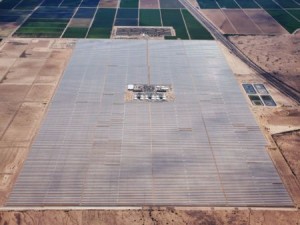Solar energy, the outcome of the most innovative technology employed ever to harness sun’s energy. It is being widely used as an alternative source of energy mainly for electricity generation, transportation (solar car), in agriculture & horticulture (greenhouse), solar water heater to name a few.
Nevertheless, there are certain drawbacks with solar energy, for instance, cost involved in the set up and irregularity/ unavailability during night or rainy days, as storage of solar energy was not so far possible. Giant Ivanpah is the largest solar thermal plant in the world but it doesn’t have a way to store its generated energy and most other plants built so far also lack that ability.
However, Abengoa Solar’s Solana plant set up in the desert near Gila Bend, Arizona, has bagged the title for the first largest thermal storage plant. The Solana plant is spread across 7.8 square kilometers with power generation capacity of 280 megawatts. The Solana plant employs 3,200 parabolic trough, which aids in concentration of the sun’s ray on to a small area to produce the heat. This heat in turn rotates the turbine that is connected to a power generator producing electricity.
The first successful attempt was conducted with running the plant’s generator with full capacity while also increasing up the thermal storage system. The generators were capable of providing electricity continuously for six long hours after the sunset.
The discussion for the researchers now is to calculate the cost involved in storage of energy as storage technologies itself requires energy and so it is only profitable if input in storage is less than its output. Currently Solana Plant uses molten salt as the prime thermal storage material which is inexpensive, readily available (other used material are paraffin wax, glauber’s salt etc) and can work on high temperatures. The industry is trying to bring those costs down and to start the full fledged operation soon in Solana. May be the initial cost for the set up are high but the long term benefit of an inexhaustible, availability in abundance, clean energy thus reducing pollution and dependency on fossil fuel and hence cannot be overlooked.
Via: IEEE Spectrum




